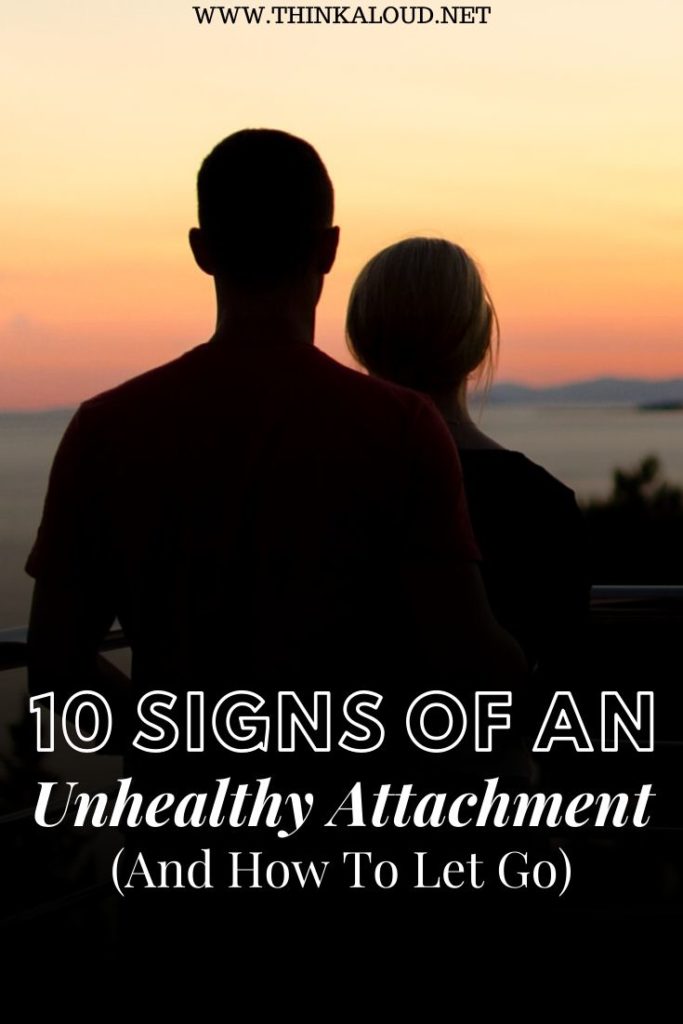10 Signs Of An Unhealthy Attachment (And How To Let Go)

All human beings form close relationships with others and it can be their romantic partner, friends, and family members. The way we form these relationships is called our adult attachment style. An unhealthy attachment can harm your mental health, and it’s time for you to take care of your own life. That is why this article is here to help you understand unhealthy attachment and see the red flags but first, you’ll have to understand attachment theory.
Attachment theory says that we have to develop a close relationship with at least one of our primary caregivers in early childhood. It’s necessary in order for emotional and social development to occur normally. Our relationships with family members from early childhood actually influence the way we form romantic relationships later on.
All human beings are in search of an emotional connection with their loved one but are we forming unhealthy relationships? Maybe you have one of the unhealthy attachment styles that I will list below. Read this article and find out.
Attachment theory and types

In the mid 1900s, psychoanalyst John Bowlby developed the attachment theory, which he based on his experiences with patients as well as his studies. His work was mostly with children and adolescents but he stated that attachments form our entire lives.
Mary Ainsworth, who worked with him, wanted to discover more about infant attachment, so she developed the Strange Situation test. Cindy Hazan and Philip Shaver later took their concepts to develop adult attachment theory.
The types of attachments for infants consist of secure, anxious-avoidant, resistant (ambivalent) and disorganized but we are going to focus on adult attachment theory in this article and list all the attachment styles. Which style is yours? Remember that you can always change it if you just decide to work on yourself.
1. Secure attachment style
If your caregivers nurtured you and were sensitive to your emotional needs, you developed a secure attachment style. Still, just because this isn’t one of the unhealthy attachment styles doesn’t mean that you won’t get into unhealthy relationships; you will just know to recognize them. This style makes it easy for you to trust that people will be there for you.
When you’re in a romantic relationship, you don’t feel jealous or scared that it will end and instead, you feel relaxed and confident. You like helping your romantic partner, and you support them.
All you want is an equal and honest relationship. If your emotional needs weren’t met as a child and this is not your style, don’t worry, as with commitment, it’s possible to develop a different style. If nothing works, you can always seek the help of a mental health specialist.
2. Anxious attachment style

If your emotional needs weren’t fulfilled or understood when you were a kid, you might have developed an anxious attachment style, which is also known as insecure attachment. You now feel the same anxiety when you start a relationship with a partner as you did when you were a kid.
It’s most likely that you’re always worried whether your loved one truly loves you and if they will keep loving you. People who have an insecure attachment are often clingy, jealous, full of anxiety and needy, and scared that the relationship is going to end. This anxious attachment style causes you to always feel like you’re not good enough. It’s like you don’t need anyone to criticize you because you do it yourself.
Emotional dependence is one of the signs of an unhealthy attachment such as anxious attachment. You are dependent on your relationship because you feel that your partner is better than you. If you’re unconsciously looking for a critical and dominant man who is not consistent in showing you affection, it’s because this is familiar to you.
3. Avoidant attachment style
People whose parents emphasized the need for you to become independent and hide your emotions often develop avoidant attachment style. This insecure-avoidant attachment could create problems because you both want and avoid intimacy. Those of you who have an avoidant attachment style dismiss the idea that emotions and intimacy are important so you focus more on being self-reliant.
Avoidant attachment causes you to become a loner so you would rather choose to be alone than enter a relationship. Maybe you don’t even know what you feel because you are so good at hiding your feelings. Avoidant attachment shows when you avoid social interactions and pursue intellectual goals so, naturally, you are attracted to those who want you to stay independent.
The anxious-avoidant style is actually anxiety from the anxious style combined with the dismissive attitude of the avoidant style.
4. Fearful-avoidant style

This is an unhealthy attachment style you develop if your parents abused, neglected, or frightened you in some way. You completely disconnect from pain, not just hide it. Maybe you are desperate for a relationship but once you’re in one, you’ll run away as soon as the feelings you disconnected from as a child appear.
This type of unhealthy attachment shows as ambivalent, disorganized, and unresolved. Either your feelings are totally disorganized, or you’re so ambivalent about relationships that you want and fear one at the same time. You’re most likely attracted to those who are abusive or neglectful.
10 signs of an unhealthy attachment
Now that you know all about attachment, it’s time to look at the signs that you should change something. People who have this problem require constant reassurance, they are too focused on their partner’s feelings and needs and steer clear of intimacy. But that’s not all, and I have selected the best 10 signs that show you have an unhealthy attachment.
After you read the signs, keep reading to find solutions to this problem. Many of us have an unhealthy attachment style, and the first step to fixing it is recognizing the problem so make sure you read all the signs and see if you have a problem like this.
1. Emotional dependence
Emotional dependence is the first of the signs of an unhealthy attachment but it is better to have healthy interdependence. You should know that you can find support in your partner but not rely solely on them, and the same goes for them. People who are in an interdependent relationship have a lot of people in their lives who can help them.
You can learn more about interdependent relationships in our other article. You shouldn’t be glued to your partner every second of every day as that is an unhealthy attachment. If you are someone who would gladly sacrifice themselves to support their partner without expecting anything in return, you’re not in an interdependent relationship. Are you incapable of enjoying yourself when you are not with your partner? If so, that’s a red flag right there.
2. Too much interest in your partner’s life

Of course, you should be interested in your partner’s life, but there is such a thing as too interested. Two people should be there for each other but your partner needs to have their own life. They are capable of doing things on their own, so you don’t need to do everything with them.
When you have an unhealthy attachment, you abandon your own interests in order to dedicate yourself to fixing their problems. Of course, that’s fine when they need you, but it’s wrong when they can do it on their own. Surely you have good intentions and think you’re being supportive but think about it from their perspective; it looks like you are questioning their capabilities and might hurt their self-esteem. That’s a red flag, and you might have an unhealthy emotional attachment.
You can have an emotional connection with your partner without hurting their self-esteem. It seems like you can no longer see the line between their life and yours. They don’t ask you for help, but you still try to rescue them. Don’t take over your partner’s life because otherwise you won’t be equals anymore. If you act like a parent to your partner then they are going to resent you for it or expect you to always fix everything.
3. It’s hard only when you’re apart
If you have an unhealthy attachment, you’ll be like a junkie wanting your fix when it comes to seeing your partner. You’ll obsess over it and really act like an addict. Still, once you get to see them, there won’t be overwhelming emotions.
All you need is to see them, touch them and be with them. You fight about when you’re going to see each other next instead of focusing on the real issues. This is not good for your mental health and is clearly an unhealthy emotional attachment.
4. They complete you
You feel like your partner completes you, which might sound romantic but is actually a sign of an unhealthy attachment. When it’s real love, both of you remain as two people, you don’t melt into one another. It’s important that you both realize you need some time away from each other and your own space.
When you truly love someone, you want what’s best for them, even if it means you won’t be involved in it but when you have an unhealthy emotional attachment, you really feel like you can’t live without your partner. That isn’t about what’s best for your partner but about what you want. The thing about an unhealthy emotional attachment is that it’s always about you. You think that you would be incomplete if your partner was to leave you.
5. Constant reassurance

All of us dream of having something meaningful with another person. We crave that deep connection that comes with an emotional bond but we tend to worry that that person is going to leave us, so we overthink and dwell on our concerns and fears. If you seek constant reassurance, it’s not healthy. After all, it never really relieves your self-doubt, does it? That can cause you to become needy and jealous and it will bother your partner.
6. Too close too soon
A lot of people have the problem that they become too close too soon. This is one of the problems I have too. You probably think it’s going to last forever as soon as you meet a person and this is a huge warning sign. It is fine to be connected to others and enjoy meeting new people but when you get too emotional and connected too fast, that’s nothing more than shallow engagement.
7. You are clingy
Maybe you think that you are loving when in fact you are clingy. Love can be strong between two people but it takes time for it to grow; it’s not something that blinds you with shallow attraction such as prestige, physical appearance, or style. If you are a clingy person, you are also a needy person. You’re trying to meet your needs with a relationship, but it won’t ever be sufficient. You are probably starving for a connection because of your experience as a child when your parents deprived you of their love.
8. Overidentifying with strangers
This is another problem I have too. We find ourselves attached to strangers who show us the slightest amount of the attention we are so desperate for. It makes us believe that all of our encounters with such strangers are much closer than they are in reality.
We are in fact starving for a powerful connection and it dates back to when we were kids. We suck people in with our emotional neediness and don’t see things clearly and this unhealthy pattern will only get us hurt in the long run.
9. Connection to people with perceived power
Do you feel connected to police officers, doctors, professors or other people who have some sort of power? You have to realize that this power is often only perceived and not actually real but it makes you attracted to those people and you believe that they will give you love and affection. People with this problem sometimes become stalkers so if you have been stalking someone’s social media profiles, give it up and don’t use social media for a while. You don’t want to become a real stalker.
10. Shallow compensating

People who don’t have faith in their own abilities tend to search for others they can mimic. This applies to you if you are someone who gets stressed because of the latest fashion trends; you get frustrated if you can’t look the way you want to. Also, you spend a lot of money on make-up, search for a good-looking partner and friends, drive a modern car, and even consider plastic surgery. What you are actually doing is searching for relational validation. You are compensating with things that are shallow.
How to let go of an unhealthy attachment
If you have recognized yourself in some of the signs, this part of the article will be especially useful to you because we are going to talk about how to fix this problem. You already took the first step by recognizing you have a problem. All you need to do right now is decide you want to fix it.
If you stay committed to that decision, it won’t really be that hard to change your life but remember that patience is crucial because change doesn’t happen overnight. You will have to be determined to change your life and advance but if you stick to that decision, you’ll see that it was worth it.
After all, you’re doing this for yourself, not anyone else. Listen to my advice and thank yourself later when the change becomes obvious. Here are the eight things you can do to improve your life and make sure you form healthy, happy relationships. Good luck!
1. Write down the reasons
It’s hard to let go when you are not sure why you have to so really think about your emotional attachments and unhealthy attachment patterns. Think about all the reasons why you have to stop and change things. Take a pen and paper and write them all down. Change is never easy, and you will be needing this list to help you stick to your decision.
Read this article again if it helps and recognize yourself in the signs I mentioned. Write down what you want to be different and what you have been doing wrong but most importantly, write down the reasons why you need to make this change in your life and let go of an emotional attachment that isn’t healthy.
2. Commit to the decision

Right now, you might feel ready and motivated to make a difference in your life and turn it around but you might not feel that way when you have to stay committed day after day. At some point, you’ll probably want to give up on it all but don’t go back to those unhealthy attachment patterns just yet.
That is why you will have written it all down in the first place. It’s time to take that list and repeat all the reasons why you need to let go of emotional attachments that aren’t healthy. Take a second to think about how your life has improved since you made the decision to let go. Change can’t happen overnight, and it takes time. Never forget the importance of patience in life and read more about why it is so important to be patient to stay motivated.
3. You’re doing it for yourself
By letting go of an unhealthy emotional attachment, you’re improving yourself, which means emotionally, mentally, and physically. This is something you’re doing for yourself, not anyone else. Improving yourself isn’t easy, but once you see and feel the change, you’ll thank yourself.
You are going to feel way better and sticking to the decision will make you feel good about yourself. I had an anxious style of emotional attachment, but with a little effort, I managed to change that. Now I form healthy, happy relationships, and I couldn’t be happier about it. You can do it too.
4. You’ll want to go back
It’s perfectly normal that you’ll want to go back to the way you were before. The emotional attachment you had created a chemical reaction in your brain. I already mentioned being like an addict in one of the signs and it really feels that way. You’ll feel bad when you try to let go, but keep it up, and it will pass.
5. Get into a relationship for the right reasons
Now that you have given up your old patterns, it’s time to make new ones. Start by getting into a relationship for the right reasons. When you’re looking for a new relationship, figure out your motives first. Are you searching for someone new just because you are afraid of being alone? Searching for a relationship for the wrong reasons often results in finding the wrong person.
6. Take it slowly

Don’t rush into a relationship as by doing so, you want to make sure that you have your partner all to yourself. Unhealthy attachments are possessive but remember what we just talked about – don’t get into a relationship for the wrong reasons. So, don’t be with someone just because you don’t want them to be with someone else. Remember to take things slowly and have the right reasons for being in a relationship.
7. Have a life outside of the relationship
If you’re doing everything with your partner, you’re doing it wrong. Everyone loves spending every minute of their day with the person they love but you have to remember that both of you need space and a life outside of the relationship. It’s good if you have your own interests and make sure you spend some time away from each other.
Don’t give up on things that your partner isn’t interested in because you can do them without him and don’t stop everything you were doing before you met your partner.
8. Spend time with your friends and family
Don’t be one of those people who forgets all about their friends and family as soon as they find a partner. Treat your friends and family with love, like you treat your partner. Make sure you spend some time with them alone, without your partner, and don’t rely on your partner for absolutely everything. Your friends and family are there to help you.





This has been the best and most comprehensive of Attachments and why we have them plus what to do about it! Very informative, concise and practical. I can’t thank you enough for this article. It has been tremendously helpful.